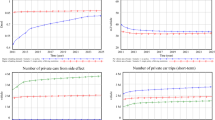Abstract
In view of the urban traffic congestion and vehicle exhaust pollution, this paper utilizes the system dynamics method to establish a traffic congestion pricing management model from the perspective of environmental and social benefits. Firstly, the charge policy in Shanghai is introduced to test, validate and simulate the model to get a relatively reasonable range of congestion charges. The results show that this policy reduces the supply level of public transport (SLPT). To this end, this paper further introduces the subsidy mechanism to improve the model and adopts the sensitivity analysis and marginal decreasing (increasing) effects to explore the reasonable subsidy range. Secondly, the combination schemes such as zero subsidy and low charge, zero subsidy and high charge, and high charge and subsidy are conducted with dynamic simulation and comparison to obtain a relatively satisfactory solution. Finally, the implementation effect of the scheme is simulated to obtain the following results: The degree of traffic congestion and amount of \(\hbox {NO}_{\mathrm{X}}\) emissions decreased by 70.27 and \(19.92\%\) after the implementation of the policy, respectively. The SLPT increased by approximately \(123.67\%\). This verifies the rationality, validity and practicability of the model.
Similar content being viewed by others
References
Walters, A.A.: The theory and measurement of private and social cost of highway congestion. Econometrical 29(4), 676–699 (1994)
Dafermos, S.; Sparrow, F.T.: Optimal resource allocation and toll patterns in user-optimized transport network. J. Transp. Econ. Policy 5(2), 198–200 (1971)
Vickrey, W.S.: Congestion theory and transport investment. Am. Econ. Rev. 59, 251–260 (1969)
Clegg, J.; Smith, M.; Xiang, Y.L.; Yarrow, R.: Bilevel programming applied to optimizing urban transportation. Transp. Res. Part B 35(1), 41–70 (2001)
Olszewski, P.; Xie, L.: Modelling the effects of road pricing on traffic in Singapore. Transp. Res. Part A 39(7), 755–772 (1969)
Wen, L.; Catay, B.; Eglese, R.: Finding a minimum cost path between a pair of nodes in a time-varying road network with a congestion charge. Eur. J. Oper. Res. 236(3), 915–923 (2014)
Eliasson, J.; Börjesson, M.; Amelsfort, D.V.; Brundell-Freij, K.; Engelson, L.: Accuracy of congestion pricing forecasts. Transp. Res. Part A 52, 34–46 (2013)
Borjesson, M.; Kristoffersson, I.: The Gothenburg congestion charge. Effects, design and politics. Transp. Res. Part A 75, 134–146 (2015)
Cen, X.K.; Hong, K.L.; Lu, L.: A framework for estimating traffic emissions: the development of passenger car emission unit. Transp. Res. Part D 44, 78–92 (2016)
Cicek, A.; Malkoc, S.; Koparal, A.S.: An investigation on the usability of grass in short term detection of traffic-related pollution. Arab. J. Sci. Eng. 37, 123–1245 (2012)
Coria, J.; Bonilla, J.; Grundstrom, M.; Pleijel, H.: Air pollution dynamics and the need for temporally differentiated road pricing. Transp. Res. Part A 75, 178–195 (2015)
Sabounchi, N.S.; Triantis, K.P.; Sarangi, S.; Liu, S.: Dynamic simulation modeling and policy analysis of an area based congestion pricing scheme for a transportation socioeconomic system. Transp. Res. Part A 59(1), 357–383 (2014)
Chen, M.C.; Chang, K.W.: Reasoning the causality of city sprawl, traffic congestion, and green land disappearance in Taiwan using the CLD model. Int. J. Environ. Res. Public Health 11, 11464–11480 (2014)
Friesz, T.L.; Bernstein, D.E.; Smith, T.E.; Tobin, R.L.; Wie, B.W.: A variational inequality formulation of the dynamic network user equilibrium problem. Oper. Res. 41(1), 179–191 (1993)
Merchant, D.K.; Nemhauser, G.L.: A model and an algorithm for the dynamic traffic assignment problems. Transp. Sci. 12(3), 183–199 (1978)
Tas, D.; Dellaert, N.; van Woensel, T.; de Kok, T.: Vehicle routing problem with stochastic travel times including soft time windows and service costs. Comput. Oper. Res. 40(1), 214–224 (2013)
Celikoglu, H.B.; Silgu, M.A.: Extension of traffic flow pattern dynamic classification by a macroscopic model using multivariate clustering. Transp. Sci. 50(3), 966–981 (2016)
Celikoglu, H.B.: Dynamic classification of traffic flow patterns simulated by a switching multimode discrete Cell Transmission Model. IEEE Trans. Intell. Transp. 15(6), 2539–2550 (2014)
Celikoglu, H.B.: Reconstructing freeway travel times with a simplified network flow model alternating the adopted fundamental diagram. Eur. J. Oper. Res. 228(2), 457–466 (2013)
Zhong, S.P.; Deng, W.; Bushell, M.: Reliability-based congestion pricing model under endogenous equilibrated market penetration and compliance rate of ATIS. J. Cent. South Univ. 22(3), 1155–1165 (2015)
Zhong, S.P.; Deng, W.; Bao, D.W.: A stochastic system optimum congestion pricing model under endogenous equilibrated market penetration and compliance rate of ATIS. Syst. Eng. Theory Pract. 33(2), 456–461 (2013)
Sun, X.; Liu, Z.Y.; Thompson, R.G.; Bie, Y.M.; Weng, J.X.; Chen, S.Y.: A multi-objective model for cordon-based congestion pricing schemes with nonlinear distance tolls. J. Cent. South Univ. 23(5), 1273–1282 (2016)
Qi, H.S.; Wang, D.H.; Chen, P.; Bie, Y.M.: Traffic jam in signalized road network. J. Cent. South Univ. 21(2), 832–842 (2014)
Alzuhairi, A.; Aldhaheri, M.; Sun, Z.B.; Oh, J.S.; Kwigizile, V.: Vehicular emissions and concentrations in school zones: a case study. J. Cent. South Univ. 23(7), 1778–1785 (2016)
Yu, D.; Wu, Y.H.; Yu, W.; Kou, S.Y.; Yang, N.: Traffic control method on efficiency of urban expressway accompanied frequent aggressive driving behavior. Arab. J. Sci. Eng. 40, 1–12 (2016)
Pratt, G.C.; Vadali, M.L.; Kvale, D.L.; Ellickson, K.M.: Traffic, air pollution, minority and socio-economic status: addressing inequities in exposure and risk. Int. J. Environ. Res. Public Health 12, 5355–5372 (2015)
Yang, H.X.; Li, J.D.; Zhang, H.; Liu, S.Q.: Research on the governance of urban traffic jam based on system dynamics. Syst. Eng. Theory Pract. 34(8), 2135–2143 (2014)
Jia, S.W.; Yan, G.L.: Optimization algorithm of Q-EUGSID and its application. Comput. Appl. Res. 33(11), 3353–3357 (2016)
Author information
Authors and Affiliations
Corresponding author
Rights and permissions
About this article
Cite this article
Jia, S., Yan, G., Shen, A. et al. A System Dynamics Model for Determining the Traffic Congestion Charges and Subsidies. Arab J Sci Eng 42, 5291–5304 (2017). https://doi.org/10.1007/s13369-017-2637-5
Received:
Accepted:
Published:
Issue Date:
DOI: https://doi.org/10.1007/s13369-017-2637-5




